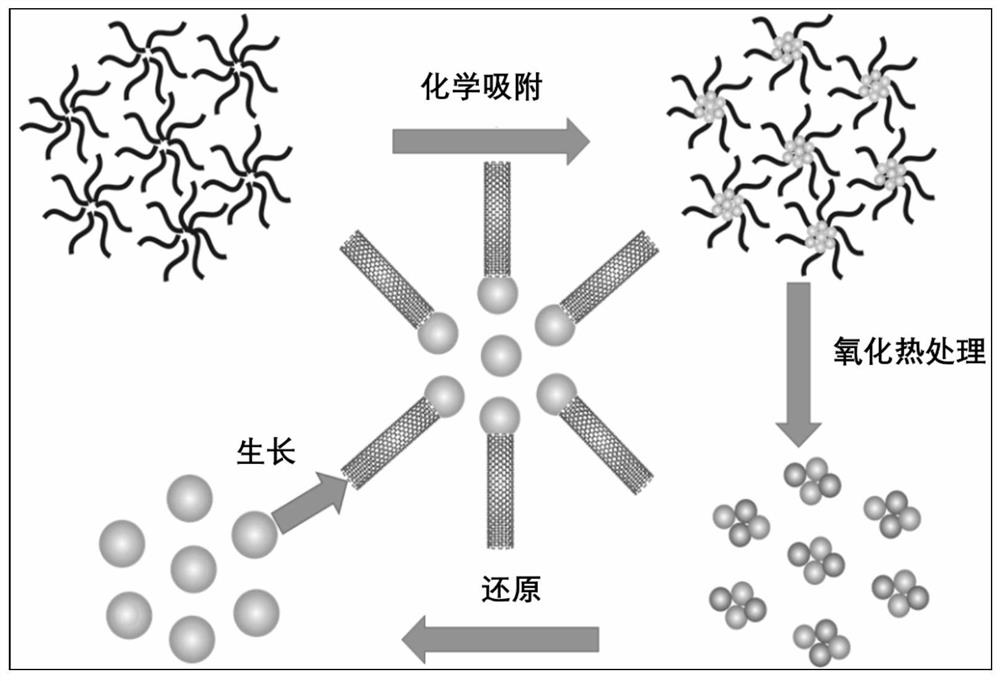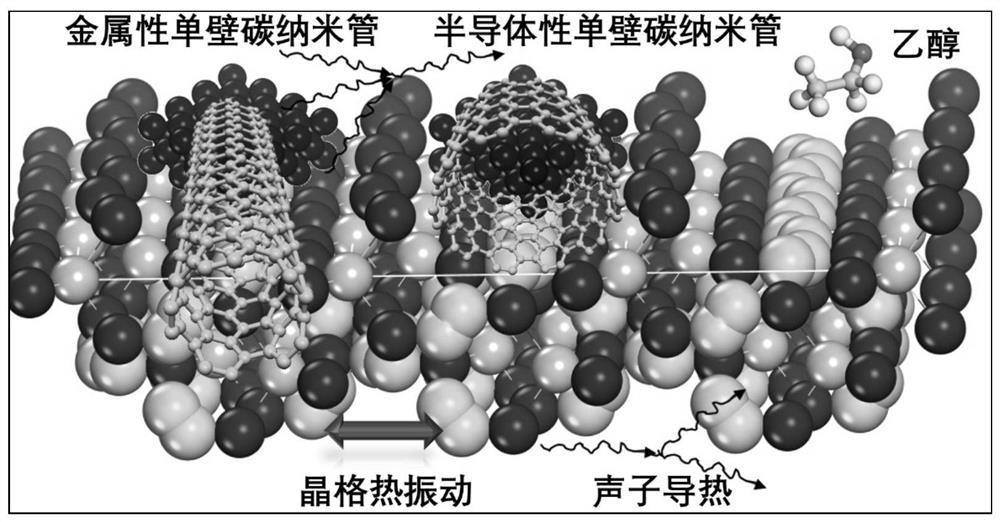A method for controllable growth of metallic single-walled carbon nanotubes through substrate design
A single-wall carbon nanotube, carbon nanotube technology, applied in the direction of carbon nanotubes, nanocarbons, non-metallic elements, etc., can solve the problems of poor high temperature thermal stability, poor uniformity of carbon nanotube diameter, poor repeatability, etc. Effects of large growth rate differences
- Summary
- Abstract
- Description
- Claims
- Application Information
AI Technical Summary
Problems solved by technology
Method used
Image
Examples
Embodiment 1
[0046] In this embodiment, the spinel containing the (110) crystal plane treated in the above step (1) is heat-treated at 450° C. for 3 hours in the air.
[0047] Adopt step (2) to support the cobalt particles on the spinel (110) surface and carry out oxidation and reduction treatment, the oxidation conditions are 450 ℃, 3min; the reduction conditions are 765 ℃, 90sccmAr+4sccmH 2 , 3min. The morphology of the cobalt particles prepared in step (2) was characterized by transmission electron microscopy ( Figure 5 a), the particle size was found to be small and uniform; the diameter distribution of cobalt particles under the transmission electron microscope ( Figure 5 b) shows that the particle size is mainly concentrated in 1-3 nm; Figure 5 Scanning transmission electron imaging of c further demonstrates the compositional homogeneity of the cobalt particles. The surface of the substrate was sputtered by X-ray photoelectron spectroscopy and secondary ion mass spectrometry, r...
Embodiment 2
[0050] In this embodiment, step (1) is the same as step (1) of the embodiment, and the temperature and time of heat treatment in air are 500° C. and 2h, respectively.
[0051] Step (2) is the same as the step (2) of the embodiment, the oxidation temperature and time are respectively 600 ℃, 1min, the reduction temperature and time are respectively 850 ℃, 1min, and the reducing atmosphere is 100sccmAr+3sccmH 2 . The size and morphology of the Co particles were characterized by transmission electron microscopy. The lattice fringe spacing of the 50 particles is centered at 0.2-0.22 nm, indicating that the substrate has a significant effect of stabilizing the catalyst structure.
[0052]Step (3) is the same as the step (3) of the embodiment, the growth temperature and time of the single-walled carbon nanotubes are respectively 775 ° C and 7min, the argon flow rate loaded with ethanol is 17sccm, the hydrogen flow rate is 1sccm, and the argon carrier gas flow rate is 90sccm. Scann...
Embodiment 3
[0054] In this embodiment, step (1) is the same as step (1) of the embodiment, and the temperature and time of heat treatment in air are 400° C. and 3h, respectively.
[0055] Step (2) is the same as the step (2) of the embodiment, the oxidation temperature and time are respectively 400 ℃, 5min, the reduction temperature and time are respectively 700 ℃, 5min, and the reducing atmosphere is 80sccmAr+5sccmH 2 . The size and morphology of the Co particles were characterized by transmission electron microscopy. The lattice fringe spacing of the 50 particles is centered at 0.2-0.22 nm, indicating that the substrate has a significant effect of stabilizing the catalyst structure.
[0056] Step (3) is the same as the step (3) of the embodiment, the growth temperature and time of the single-walled carbon nanotubes are respectively 765 ° C and 10min, the argon flow rate loaded with ethanol is 20sccm, the hydrogen flow rate is 3sccm, and the argon carrier gas flow rate is 100sccm. Sca...
PUM
| Property | Measurement | Unit |
|---|---|---|
| length | aaaaa | aaaaa |
| diameter | aaaaa | aaaaa |
| size | aaaaa | aaaaa |
Abstract
Description
Claims
Application Information
 Login to View More
Login to View More - R&D
- Intellectual Property
- Life Sciences
- Materials
- Tech Scout
- Unparalleled Data Quality
- Higher Quality Content
- 60% Fewer Hallucinations
Browse by: Latest US Patents, China's latest patents, Technical Efficacy Thesaurus, Application Domain, Technology Topic, Popular Technical Reports.
© 2025 PatSnap. All rights reserved.Legal|Privacy policy|Modern Slavery Act Transparency Statement|Sitemap|About US| Contact US: help@patsnap.com



